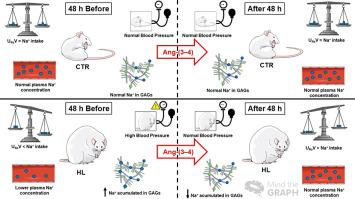Biochimica et Biophysica Acta (BBA) - Molecular Basis of Disease ( IF 6.2 ) Pub Date : 2020-11-16 , DOI: 10.1016/j.bbadis.2020.166012 Rafael Luzes 1 , Thuany Crisóstomo 2 , Paulo A Silva 3 , Roxane Iack 3 , Virgínia Genelhu de Abreu 3 , Emílio A Francischetti 3 , Adalberto Vieyra 4

|
Hypertension, one of the most common and severe comorbidities of obesity and overweight, is a worldwide epidemic affecting over 30% of the population. We induced overweight in young male rats (aged 58 days) by exposure to a hypercaloric high lipid (HL) diet in which 70% of the calories originated from fat. The HL diet also contained 33 or 57% higher Na+ than the control (CTR) diet. Over the following weeks the HL rats gradually became overweight (490 ± 12 g vs 427 ± 7 g in the CTR group after 15 weeks) with high visceral fat. They developed elevated systolic blood pressure (SBP) (141 ± 1.9 mmHg), which was fully restored to CTR values (128 ± 1.1 mmHg) by oral administration of Ang-(3–4) (Val-Tyr), the shortest renin-angiotensin-derived peptide. The overweight rats had lower plasma Na+ concentration that augmented to CTR values by Ang-(3–4) treatment. Na+ ingestion was depressed by 40% as result of the Ang-(3–4) treatment, whereas the urinary excretion of Na+ (UNaV) remained unmodified. The preservation of UNaV after Ang-(3–4) treatment – despite the sharp decrease in the dietary Na+ intake – can be ascribed to the normalization of renal type 1 angiotensin II receptors and Na+-transporting ATPases, both up-regulated in overweight rats. These renal effects complete a counterregulatory action on elevated renin-angiotensin activity that allows the high SBP to be normalized and body Na+ homeostasis to be restored concomitantly in overweight rats.
中文翻译:

血管紧张素(3-4)使血压正常化,降低Na +和能量摄入,但保留超重高血压大鼠的尿Na +排泄
高血压是肥胖和超重最常见,最严重的合并症之一,是一种全球性流行病,影响了30%以上的人口。我们通过暴露于高热量高脂(HL)饮食中诱导了年轻雄性大鼠(58岁)的超重,其中70%的卡路里来自脂肪。HL饮食还比对照(CTR)饮食含33 + 57%高的Na +。在接下来的几周中,HL大鼠逐渐变得超重(15周后CTR组为490±12 g,而CTR组为427±7 g),并伴有高内脏脂肪。他们的收缩压(SBP)升高(141±1.9 mmHg),通过口服Ang-(3–4)(Val-Tyr)(肾素最短)可完全恢复至CTR值(128±1.1 mmHg)。血管紧张素衍生的肽。超重的大鼠血浆Na +较低通过Ang-(3-4)处理增加到CTR值的浓度。Ang-(3-4)治疗使Na +的摄入降低了40%,而Na +(U Na V)的尿排泄仍然未改变。Ang-(3-4)治疗后U Na V的保存-尽管饮食中Na +摄入量急剧减少-可归因于肾脏1型血管紧张素II受体和Na +转运ATP酶的正常化,两者均升高。调节超重大鼠。这些肾功能对肾素-血管紧张素活性的升高完成了反调节作用,使高SBP得以正常化,体内Na + 超重大鼠同时恢复体内稳态。


























 京公网安备 11010802027423号
京公网安备 11010802027423号